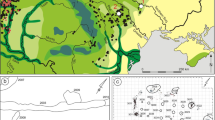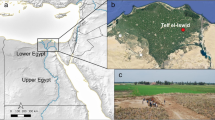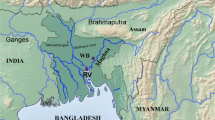Abstract
Several urban medieval sites in Finland (ad 1000–1500) have been archaeobotanically investigated, but until now only a few rural medieval settlements have been studied. Therefore, many aspects of the crops and agricultural methods of medieval villages in Finland still remain unknown. At the 12th to mid-16th century medieval village of Mankby, Espoo, a systematic sampling for archaeobotanical material was carried out. The analysed samples derived from hearths, building contexts and medieval field layers etc. The archaeobotanical material was carbonised, and it consisted mostly of conifer needles, cereal grains and weed seeds. Secale cereale (rye) and Hordeum vulgare (barley) were the only crop species found, Secale being the most frequent. Seeds of Bromus secalinus (rye brome) and achenes of Centaurea cyanus (cornflower), which are associated with autumn sown winter cereal crops, were also present. The archaeobotanical material shows areas of activity linked to storing crops, as well as cultivation within the village boundaries. Based on radiocarbon dated grains, cultivation of the fields started in the 12th century and continued until the abandonment of the village in 1556. Archaeobotanical material from Mankby has been compared to other contemporary sites in Finland, and differences between the sites can be seen. Results from Mankby have added to our knowledge of medieval agriculture, past areas of activity and economic conditions within the village.



Similar content being viewed by others
References
Aalto M (1997) The cultivated plants of Finnish Iron Age. In: Kirpichnikov AN, Ryabinin EA, Saksa AI (eds) Slavyane i finno-ugry: arkheologiya, istoriya, kultura: doklady rossiysko-finlyandskogo simpoziuma po voprosam arkheologii (Slavs and Finno-Ugrics: archaeology, history, culture: reports of the Russo-Finnish symposium on archaeology, in Russian). Dmitriy Bulanin, Sankt-Peterburg, pp 47–61
Alanko T (1998) Arkeobotaaninen tutkimus Naantalin keskiaikaiselta luostarikirkolta (Archaeobotanical research on the medieval abbey church of Naantali, in Finnish). Unpublished master’s Thesis, University of Turku, Department of Biology
Alenius T (2008) The palaeoecological study of three mires on the island Kemiönsaari, SW Finland. In: Asplund H (ed) Kymittae. Sites, centrality and long-term settlement change in the Kemiönsaari region in SW Finland. Annales Universitatis Turkuensis B 312, Appendix 2
Alenius T (2011) From forest to a farmland. Palaeoenvironmental reconstruction of the colonization of Western Uusimaa: Maritime landscape in change. The Finnish Antiquarian Society, ISKOS 19:87–116
Alenius T, Mökkönen T, Lahelma A (2013) Early farming in the Northern Boreal zone: reassessing the history of land use in Southeastern Finland through high-resolution pollen analysis. Geoarchaeol 28:124
Alenius T, Haggrén G, Oinonen M, Ojala A, Pitkänen RL (2014) The history of settlement on the coastal mainland in Southern Finland. Palaeoecological, archaeological, and etymological evidence from Lohjansaari Island, Western Uusimaa, Finland. J Archaeol Sci 47:99–112
Allardt A (1898) Borgå läns sociala och ekonomiska förhållanden åren 1539–1571. (Social and economic conditions in Borgå county in 1539–1571, in Swedish). Tidnings-och tryckeri-aktiebolag, Helsingfors
Asplund H, Vuorela I (1989) Settlement studies in Kemiö—Archaeological problems and palynological evidence. Fennoscandia Archaeologica 4:67–79
Behre K-E (1992) The history of rye cultivation in Europe. Veget Hist Archaeobot 3:141–156
Beijerinck W (1947) Zadenatlas der nederlandsche Flora. (Mededeeling van het Biologisch Station te Wijster, Drenthe 30). Veenman en Zonen, Wageningen
Bronk Ramsey C (2009) Bayesian analysis of radiocarbon dates. Radiocarbon 51:337–360
Cappers RTJ, Bekker RM, Jans JEA (2006) Digital seed atlas of the Netherlands. Barkhuis, Groningen
Evans J, O´Connor T (1999) Environmental archaeology. Principles and methods. Sutton Publishing, Gloucestershire
Grabowski R (2011) Changes in cereal cultivation during the Iron Age in southern Sweden: a compilation and interpretation of the archaeobotanical material. Veget Hist Archaeobot 20:479–494
Grabowski R (2013) Cereal cultivation in east-central Jutland during the Iron Age, 500 bc–ad 1100. Dan J Archaeol 2:164–196
Haggrén G (2010) Leipäviljaa ja lypsykarjaa. Maatalous keskiajan ja uuden ajan taitteen Raaseporin läänissä. (Grains for bread, livestock for milking. Agriculture in the county of Raasepori at the turn of the medieval to the early modern period, in Finnish) In: Hirvilammi J (ed) Varhainen viljely Suomessa (Early cultivation in Finland, in Finnish). Suomen maatalousmuseo Sarka. Kopijyvä, Jyväskylä, pp 132–158
Haggrén G, Latikka J (2004) Espoo, Espoonkartanon alueen historiallisen ajan muinaisjäännösten inventointi 2004 (Inventory of antiquities of the historical period in the Espoo area in 2004, in Finnish). Tutkimusraportti. National Board of Antiquities, Helsinki
Haggrén G, Rosendahl U (2008) Mankbyn kylä ja sen viimeiset asukkaat—epilogi. Kylä—keskiaikaa Itämeren rannalla (Mankby village and its past inhabitants, an epilogue—the village, everyday life by the Baltic Sea, in Finnish). Espoon kaupunginmuseo, Espoo, pp 132–137
Häkkinen K, Lempiäinen T (1996) Die ältesten Getreidepflanzen der Finnen und ihre Namen. Finnisch Ugrische Forschungen 53:148–149
Hämet-Ahti L, Suominen J, Ulvinen T, Uotila P (1998) (eds) Retkeilykasvio (Field flora of Finland, in Finnish). 4th edn. Finnish Museum of Natural History, Helsinki
Jacomet S, Kreuz A (1999) Archäobotanik. Ulmer, Stuttgart
Jansson H, Haggrén G, Mannermaa K, Tenhunen T (2010) Settlement history and economy of the Gunnarsängen site at the Hanko peninsula. Fennoscandia Archaeologica 27:69–88
Kalliola R (1973) Suomen kasvimaantiede (Phytogeography of Finland, in Finnish). WSOY, Porvoo
Lagerås P (2008) Resultat av makrofossilanalys från Skegrie SU, bilaga 4 (Results of macrofossil analyses from Skegrie, in Swedish). In: Schmidt Sabo K (ed) Bronsålder på toftmark och medeltid på gård nr 12 i Skegrie: Rapport. (Bronze Age at a toftland and medieval at a farm in Skegrie: Report, in Swedish). Riksantikvarieämbetet, Lund
Lagerås P (2010) Den agrara ekonomin och växtutnyttjandet i Örja – analyser av växtmakrofossil och pollen (Agricultural economy and plant usage in Örja—analyses of plant macrofossil and pollen, in Swedish). In: Schmidt Sabo K (ed) Örja 1:9: Rapport (Örja 1:9, Report, in Swedish). Riksantikvarieämbetet, Lund
Latałowa M, Badura M, Jarosińska J, Święta-Musznicka J (2007) Useful plants in medieval and post-medieval archaeobotanical materials from the Hanseatic towns of northern Poland (Kołobrzeg, Gdańsk and Elbląg). In: Karg S (ed) Medieval food traditions in Northern Europe. (Publications from the National Museum, Studies in Archaeology and History 12). National Museum of Denmark, Copenhagen, pp 39–72
Lempiäinen T (1993) Pflanzliche Makroreste von der wikingerzeitlichen—frühmittelalterlichen Siedlung Varikkoniemi in Hämeenlinna. Suomen Museo, Helsinki, pp 109–128
Lempiäinen T (1994a) Raison Mullin makrofossiili- eli kasvijäännetutkimukset. (Macrofossil analysis from Raisio Mulli, in Finnish). Tutkimusraportti. University of Turku, Herbarium
Lempiäinen T (1994b) Kuusiston linnan kasvijäännetutkimukset: Raportti. (Macrofossil analysis from Kuusisto Castle: Report, in Finnish). Museovirasto, Helsinki
Lempiäinen T (1996) Liedon Rähälän keskiaikaisen asuinpaikan viljavarasto—lisää tietoa Aurajokilaakson viljanviljelystä. (A supply of cereals discovered at the Rähälä medieval settlement site in Lieto—additional information about cultivation in the Aurajoki valley, in Finnish). Kentältä poimittua 3. Kirjoitelmia arkeologian alalta. Museoviraston arkeologian osaston julkaisuja no 6. Museovirasto, Helsinki, pp 110–117
Lempiäinen T (2001) Hattula Retulansaari. Makrofossiilianalyysi (Hattula Retulansaari. Macrofossil analysis, in Finnish). Tutkimusraportti. University of Turku, Herbarium
Lempiäinen T (2003) Espoo Kauklahti Saka. Makrofossiilitutkimus (Espoo Kauklahti Saka. Macrofossil research, in Finnish). Tutkimusraportti. University of Turku, Herbarium
Lempiäinen T (2005) Ruis rautakauden Suomessa ja Katariinan Kirkkomäen ruisolkipunos (Rye during the Iron Age in Finland and rye straw braid from Katariina Kirkkomäki, in Finnish). In: Immonen V, Haimila M (eds) Mustaa valkoisella. Ystäväkirja Kristiina Korkeakoski-Väisäselle (Black on white. A book dedicated to Kristiina Korkeakoski-Väisänen, in Finnish). Dark Oy, Vantaa, pp 110–118
Lempiäinen M (2006a) Espoo Suomenoja Finno. Keskiaikaisen kylätontin kasvimakrofossiilitutkimukset. (Espoo Suomenoja Finno. Macrofossil analyses from a medieval village, in Finnish). Tutkimusraportti. University of Turku, Herbarium
Lempiäinen M (2006b) Hattula Retulansaari Myllymäki ja Ylikartano (Hattula Retulansaari Myllymäki and Ylikartano, in Finnish). Tutkimusraportti University of Turku, Herbarium
Lempiäinen T (2007) Archaeobotanical evidence of plants from the medieval period to early modern times in Finland. In: Karg S (ed) Medieval food traditions in Northern Europe. (Publications from the National Museum, Studies in Archaeology and History 12). National Museum of Denmark, Copenhagen, pp 97–112
Lempiäinen M (2008) Parikkala, Uukuniemi, Papinniemi. 1600-luvulle ajoittuvan ortodoksikylän asuinpaikan kasvijäännetutkimus maanäytteistä ja savitiivisteistä. (Parikkala, Uukuniemi, Papinniemi. Macrofossil analysis from soil samples and daubs from 17th century orthodox village, in Finnish). Tutkimusraportti. University of Turku, Herbarium
Lempiäinen M (2010a) Espoo Mankåker. Kasvimakrofossiilitutkimus. (Espoo Mankåker. Plant macrofossil analysis, in Finnish). Tutkimusraportti. University of Turku, Herbarium
Lempiäinen T (2010b) Muinaisten peltojen rikkaruohot makrofossiiliaineistossa (Weed seeds in macrofossil material from ancient fields, in Finnish). In: Hirvilammi J (ed) Varhainen viljely Suomessa (Early cultivation in Finland, in Finnish). Suomen maatalousmuseo Sarka. Kopijyvä, Jyväskylä, pp 4–19
Lyman RL (1994) Vertebrate taphonomy. Cambridge University Press, Cambridge
Matiskainen H (1984) Getreidekörner aus der späteisenzeitlichen Siedlungskammer Domargård I in Karjaa, Südfinnland. Fennoscandia Archaeologica 1:43–50
Myrdal J (1985) Medeltidens åkerbruk. Agrarteknik i Sverige ca 1000 till 1520 (Medieval cultivation. Agrarian technology in Sweden ca 1000 to 1520, in Swedish). Nordiska museets handlingar 105. Centraltryckeriet, Borås
Myrdal J, Söderberg J (1991) Kontinuitetens dynamik. Agrar ekonomi i 1500-talets Sverige (Dynamics of continuity. Agrarian economy in Sweden during the 16th century, in Swedish). (Stockholm Studies in Economic History 15). Stockholm University, Stockholm
Onnela J, Lempiäinen T, Luoto J (1996) Viking Age cereal cultivation in SW Finland—a study of charred grain from Pahamäki in Pahka, Lieto. Ann Bot Fennici 33:237–255
Orrman E (2003) Keskiajan maatalous (Medieval agriculture, in Finnish). In: Rasila V, Jutikkala E, Mäkelä-Alitalo A (eds) Suomen maatalouden historia 1 (The history of agriculture in Finland 1, in Finnish). SKS, Helsinki, pp 87–114
Österberg E (1977) Kolonisation och kriser. Bebyggelse, skattetryck, odling och agrarstruktur i västra Värmland ca 1300–1600 (Colonization and crises. Buildings, tax burden, cultivation and agrarian structure in western Värmland ca 1300–1600, in Swedish). Bibliotecha Historica Lundensis, Lund
Pearsall D M (2000) Paleoethnobotany. A handbook of procedures, 6th edn. Academic Press, San Diego
Pihlman S, Seppä-Heikka M (1985) Indication of Late-Neolithic cereal cultivation at the Kotirinne dwelling site at Niuskala, Turku, SW Finland. Memoranda Soc Fauna Flora Fennica 61:85–88
Ramsay A (1924) Esbo: Esbo socken och Esbogård på 1500-talet (Esbo: Esbo parish and Esbogård during the 16th century, in Swedish). Söderström, Helsingfors
Reimer PJ, Bard E, Bayliss A et al (2013) IntCal13 and Marine13 radiocarbon age calibration curves 0–50,000 years cal bp. Radiocarbon 55:1,869–1,887
Renfrew C, Bahn P (1994) Archaeology: theories, methods and practice. Thames and Hudson, London
Robinson D, Siemen P (1988) A Roman Iron Age funerary deposit from Præestestien, southwestern Jutland, and the early cultivation of rye in Denmark. Antiquity 62:697–703
Rösch M, Jacomet S, Karg S (1992) The history of cereals in the region of the former Duchy of Swabia (Herzogtum Schwaben) from the Roman to the Post-medieval period: results of archaeobotanical research. Veget Hist Archaeobot 1:193–231
Rosendahl U (2015) The horizontal stratigraphy of a medieval hamlet. META 2015:133–148
Rosendahl U, Salonen A-M (2015) Mankbyn riihi. Kuninkaankartanon pitkäaikainen tuotantorakennus (Drying barn at Mankby. A building at King´s manor, in Finnish). SKAS 3/2015:14–22
Seppä-Heikka M (1983) Esihistoriallisia siemeniä ja kasvipainanteita Paimion Sievolan myöhäisrautakautiselta asuinpaikalta (Prehistoric seeds and plant impressions from the settlement site at Paimio Sievola, in Finnish). Karhunhammas 7:39–46
Seppä-Heikka M (1986) Grains and seeds from younger Roman Iron Age excavations in Spurila. The Finnish Antiquarian Society, ISKOS 5:460–461
Sillasoo Ü, Hiie S (2007) An archaeobotanical approach to investigating food of the Hanseatic period in Estonia. In: Karg S (ed) Medieval food traditions in Northern Europe. (Publications from the National Museum, Studies in Archaeology and History 12). National Museum of Denmark, Copenhagen, pp 73–96
Sjörs H, Jonsell B, Elven R (2004) Features of Nordic environment and vegetation. In: Jonsell B (ed) Flora Nordica. General volume. The Royal Swedish Academy of Sciences. Grahns Tryckeri AB, Lund
Soininen AM (1974) Vanha maataloutemme. Maatalous ja maatalousväestö Suomessa perinnäisen maatalouden loppukaudella 1720-1870-luvulla (Traditional agriculture in Finland 1720–1870, in Finnish). Historiallisia tutkimuksia, Suomen historiallinen seura, Forssan Kirjapaino Oy
Speleers L, Van der Valk JMA (2015) Economic plants from medieval and post-medieval Brussels (Belgium), an overview of the archaeobotanical records. Quat Int. doi:10.1016/j.quaint.2015.11.025
Tolonen M (1985) Cereal cultivation with particular reference to rye: some aspects on pollen-analytical records from SW Finland. Fennoscandia Archaeologica 2:85–89
Van Zeist W, Woldring H, Neet R (1994) Plant husbandry and vegetation of early medieval Douai, northern France. Veget Hist Archaeobot 3:191–218
Vanhanen S (2010) Kasvinjäänteet kertovat elinkeinoista (Plant remains telling about livelihoods, in Finnish). In: Koivisto A, Koivisto R, Hako J (eds) Gubbacka. Keskiajan arkea Vantaalla (Gubbacka. Medieval daily life in Vantaa, in Finnish). Museoviraston rakennushistorian osaston julkaisuja 34. Bookwell Oy, Porvoo, pp 142–159
Vanhanen S (2012) Archaeobotanical study of a Late Iron Age agricultural complex at Orijärvi, eastern Finland. Fennoscandia Archaeologica 29:55–72
Vanhanen S, Mikkanen T (2013) New radiocarbon dates for a medieval oven with botanical remains from the hamlet of Gubbacka, Vantaa, Southern Finland. SKAS 1–2:16–24
Vestbö-Franzen A (2004) Råg och rön. Om mat, människor och landskapsförändringar i norra Småland, ca 1550–1700 (Research on rye. Food, humans and structural changes in the agrarian landscape of Northern Småland, 1550–1700, in Swedish). Stockholm University, Stockholm
Viklund K (1998) Cereals, weeds and crop processing in Iron Age Sweden. Methodological and interpretative aspects of archaeobotanical evidence. (Archaeology and Environment 14). University of Umeå, Umeå
Viklund K (2007) The long history of Swedish bread. Continuity and change in Swedish regional bread-cereal traditions. Laborativ Arkeologi 7:30–36
Vilkuna A-M (2003) Kruunun maatalous: kuninkaankartanot (Agriculture of the Crown: King’s manors, in Finnish). In: Rasila V, Jutikkala E, Mäkelä-Alitalo A (eds) Suomen maatalouden historia 1 (The history of agriculture in Finland 1, in Finnish). SKS 914:1. Gummerus Kirjapaino Oy, Helsinki, pp 246–268
Vuorela I, Lempiäinen T (1988) Archaeobotany of the site of the oldest cereal grains find in Finland. Ann Bot Fennici 25:33–45
Wallin J-E (1996) History of sedentary farming in Ångermanland, northern Sweden, during the Iron Age and Medieval period based on pollen analytical investigations. Veget Hist Archaeobot 5:301–312
Acknowledgements
This study was funded by grants from the Kone Foundation and the Finnish Cultural Foundation. We especially wish to thank Karl-Ernst Behre, Terttu Lempiäinen and Julian Wiethold (Institut national de recherches archéologiques preventives, Laboratoire archéobotanique, Metz, France) as well as an anonymous referee, whose valuable comments helped to improve this paper. The final version of the manuscript has benefited from a linguistic revision by Tapani Hopkins (Zoological Museum, University of Turku).
Author information
Authors and Affiliations
Corresponding author
Additional information
Communicated by K.-E. Behre.
Rights and permissions
About this article
Cite this article
Lempiäinen-Avci, M., Haggrén, G., Rosendahl, U. et al. Archaeobotanical analysis of radiocarbon-dated plant remains with special attention to Secale cereale (rye) cultivation at the medieval village of Mankby in Espoo (Finland). Veget Hist Archaeobot 26, 435–446 (2017). https://doi.org/10.1007/s00334-017-0604-4
Received:
Accepted:
Published:
Issue Date:
DOI: https://doi.org/10.1007/s00334-017-0604-4




